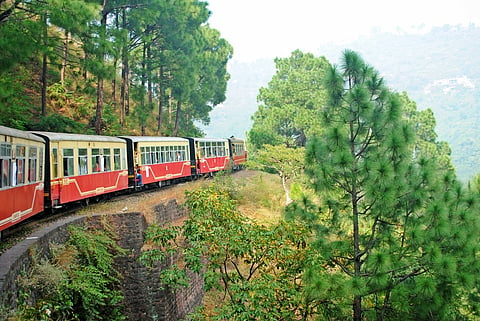
- Destinations
- Experiences
- Stay
- What's new
- Editor’s Picks
- Responsible Tourism
- CampaignsCampaigns
- Subscribe

The Kalka-Shimla Railway, which previously stopped at 18 stations, will now stop at only eight. The reason is the heavy monsoon this year, which resulted in continuous rain, severely damaging the British-era railway track. More than 300 sites have had to undergo repair work, according to reports. In September 2023, the railways were able to reopen six toy trains and a Rail Motor Car (RMC) on the route.
Kanoh, Kathleeghat, Shogi, Taradevi, Kathlighat, Kumarhatti, Sanwara, Koti, Gumman, and Taksal are the stations where the Kalka-Shimla railway will no longer stop. According to reports, the decision was made to remove the stations from the route in order to reduce travel time. However, this is a temporary measure, and the authorities have said they are open to suggestions.
The 96-km long, single track Kalka-Shimla railway is one of the three Mountain Railways of India listed as UNESCO World Heritage. Built in 1903 under the British, the train chugs along acres of lush greenery, over multiple bridges and through 100 tunnels over this track.
In November 1903, a steam engine called the Hill Puffer chugged out of Kalka with the viceroy, Lord Curzon on board. Seven hours later, after passing through 109 tunnels (the longest, at Barog, being nearly a kilometer long), crossing 969 bridges, 919 curves, and passing 20 railway station it pulled into Shimla, the summer capital of British India. The Kalka-Shimla toy train had climbed more than 4,800 feet over a distance of 96 km, bringing Shimla within easy reach of travelers from the plains.
In 2021, the Kalka Shimla heritage railway announced that the Ambala Division of the Northern Railway Zone is introducing a hop-on, hop-off service, on a single ticket, and valid for a full calendar day. In 2023, this mountain railway launched a few Vistadome coaches with a see-through glass roof which provide mesmerising views of the passing landscape.
In 2018, the authorities at the Kalka railway station announced the launch of a small museum on site. A British-era parcel cabin box counter situated at the station was selected to display the uniforms worn by railway employees during the British era, old tickets of the Kalka-Shimla train, and old photographs of the steam engine. The station is decorated with large scale paintings of the locomotives running through spectacular mountainous vistas.
